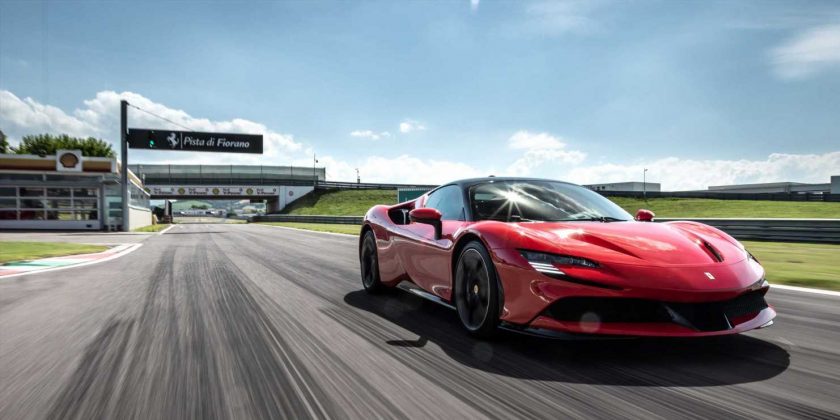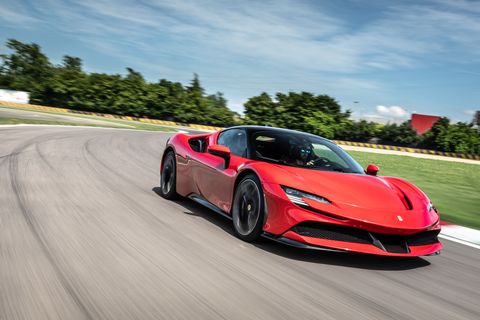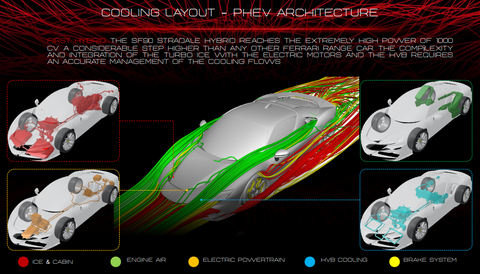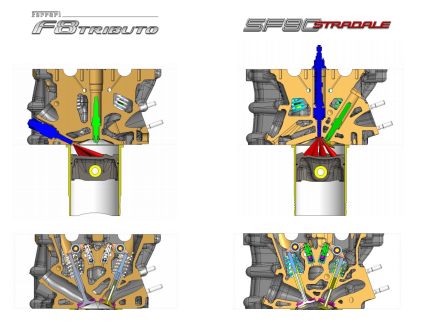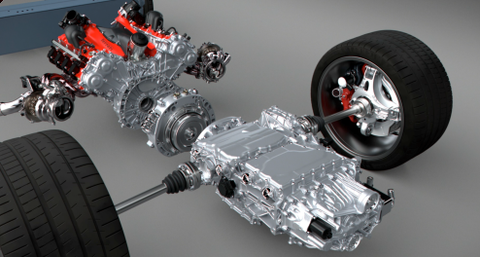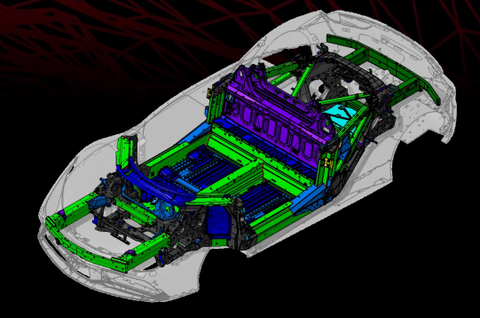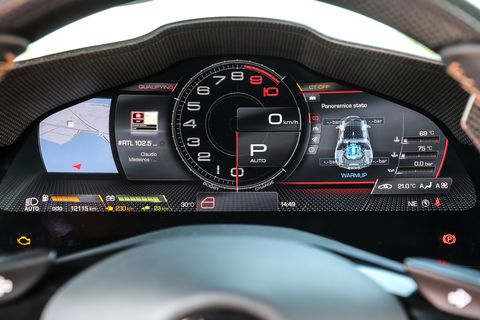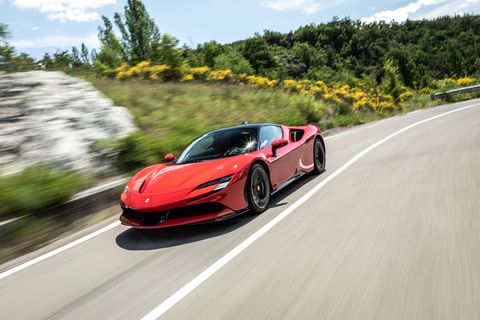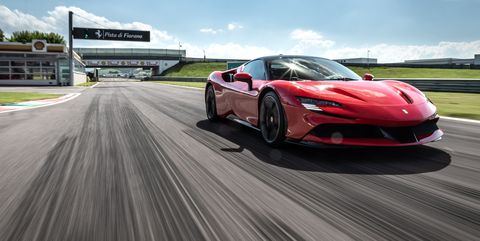
Having just spent some thoroughly splendid time in Ferrari’s amazing new SF90 plug-in hybrid supercar, I had a look back at all the technology that makes it work so well in almost everything it does. And? There is no single thing that stands out for this bella macchina; rather, it is the melding of all the parts and systems working seamlessly together that creates what is now my new all-time favorite sports- or supercar ever. It offers all the power and handling of the best of the class without beating the living crap out of you. Scroll down to see all the work Ferrari did to make the Scuderia Ferrari 90 the worthy successor to the La Ferrari, Enzo, F50, F40, and 288 GTO. There’s a lot going on under that sensuous skin.
This is the most beautiful shape since the P4. There, I said it. Go ahead and argue all you want, but what is more beautiful than this? Granted, it is derivative and clearly evolved from the F8, 488, 458, 360, etc., but it is the most beautiful evolution of them all.
Every square centimeter of that beautiful shape serves a practical purpose. Air must be routed to cool the internal combustion engine, the cabin, e-Powertrain, and numerous radiators. Even the wheels suck air out through the brakes to cool them. In back, the active aero utilizes two wings: for low-drag, high-speed driving like down the Hunaudieres Straight, the air flows between the two levels; for low-speed, high-downforce corners, like at the Nürburgring, a feature called the “Shut-Off Gurney Flap” lowers, blocks the airflow under the top wing and forces it up, creating 860 pounds of downforce at 186 mph. Underneath the car, on the flat underside, are two vortex generators that increase downforce by 30 percent compared to the F8.
“This is the most aerodynamically efficient car in the Ferrari range,” said Matteo Biancalana, head of aerodynamics at Ferrari. “Aerodynamics influences virtually the entire body surface and the whole of the underbody.”
The 4.0-liter twin-turbo internal-combustion V8’s 769 hp makes it the most powerful V8 in Ferrari history—and just 50 hp shy of the V12 in the limited-edition 812 Competizione.
You may think you see similarities to the twin-turbo V8 in the F8 and 488 (and even the California T), but almost everything on this engine has been changed for the SF90. It has: new intake and exhaust camshafts for higher flow capacity and better turbulence; new crankshaft, con rods, cylinder liners, and pistons; a new intake manifold with reduced volume for optimized volumetric efficiency and knock mitigation; a bigger exhaust manifold for reduced pumping losses; and new intake and exhaust lines.
The injectors for the gasoline direct injection have been moved from the side of the cylinder head to the top so they squirt high-pressure benzina into the chamber in a more efficient, effective manner at over 5000 psi. The cylinder bores have been widened from 86.5 mm to 88 to accommodate both the new injectors and the valves, bumping displacement up to just 10 ccs shy of 4.0 liters. The intake ducts are shorter for higher flow with greater tumble, to mix things up more thoroughly for better combustion. The turbos are the same size as those on the F8 but with larger compression volutes and a new wastegate valve shape. All that combines to make 769 SAE hp from the internal combustion engine alone. Now, the electric motors.
The SF90 is Ferrari’s first plug-in hybrid (the 2013 La Ferrari, you’ll recall, was not a plug-in, just a hybrid).
“The hybrid system is pretty complex,” said Luca Poggio, head of Ferrari’s hybrid department.
Only if you have to design it. To explain it is much easier. There are three electric motors, all fed from a slim 7.9-kWh battery mounted like a cross brace just behind the seats. The rearmost battery is pizza-thin and pizza round, and is called MGUK (Motor Generator Unit, Kinetic). Ferrari says the name and the technology comes from F1. It’s bolted in between the engine and the eight-speed DCT transmission, just aft of the flywheel on the longitudinally mounted, mid-rear V8.
Up front are two more electric motors, each driving its own front wheel to better allow torque vectoring and all its benefits. The three electric motors make 217 hp, so that altogether this powertrain makes 986 hp. I know you’ve seen the figure 1000 hp for the SF90, but that is in cavallino, or CV, a sort of metric Italian horsepower. Here in America we use SAE hp, which is where we get that 986-horsepower total. Feel free to round it up to 1000 when discussing the car with your friends after you buy one.
Aft of the V8 and rear electric motor is an all-new eight-speed DCT transmission that completes the powertrain perfectly. Ferrari says the SF90 Stradale sports a completely redesigned eight-speed, oil-bath, dual-clutch transmission. New gear ratios and improved efficiency reduce fuel consumption by 8% on the overly optimistic European WLTP cycle.
Like the V8, the DCT uses a dry sump and a significantly more compact clutch assembly with a 20% smaller exterior diameter than the current gearbox, has shaved 15 mm off the installed height in the car, which, in turn, lowers the center of gravity of the running gear by the same amount. Despite the addition of an eighth gear and a maximum torque boost to 900 Nm (the latter an increase of 20% on the current seven-speed), the gearbox’s overall weight is actually 7 kg lower. That figure rises to 10 kg with the elimination of the reverse gear—now incorporated in the function of the front electric motors.
The new clutch’s performance is 35% higher, transmitting up to 885 lb-ft in dynamic torque in gear shifts. Thanks to new-generation actuation hydraulics, total clutch fill times have been cut to 200 ms compared to the 488 Pista’s 300 ms. Just pull back on the paddle shifters and you are cracking through gears just for the fun of listening to the V8 engine roar and burble.
If you look at pictures of the two bodies-in-white side-by-side, they make look similar, but Ferrari assures us that the chassis has been completely redesigned. It’s still mostly aluminum, but there’s a carbon-fiber bulkhead behind the seats, a superalloy called Inconel throughout, and some of the aluminum is now hollow-cast. There are also new aluminum alloys for greater strength. This results in a body that has 40% greater torsional rigidity and 20% more bending resistance—all with no increase in weight.
The Fiorano Pack that was on my SF90, and which you should order on yours, comes with even more carbon fiber throughout, including the seats, hood, bumpers, wheels, deck lid, spoiler, and intake plenum. The Fiorano pack also gets titanium springs and aluminum shock housings for weight savings.
There are more acronyms on this car than in a branch of the Federal government, but taken together they make the whole car work effortlessly. Ferrari says the new hybrid architecture required “extensive and lengthy integration work on the car’s many different control logics.” That includes high-voltage system controls (battery, RAC-e, MGUK, inverter), engine and gearbox control, and vehicle dynamics controls (traction, braking, Torque Vectoring).
New systems were invented to introduce new features. The eSSC (electronic Side Slip Control) has three means to distribute torque to all four wheels: Electric Traction Control (eTC) distributes torque to the individual wheels, brake-by-wire control with ABS/EBD splits braking between the hydraulic system and the electric motors, Torque Vectoring sends torque to individual front wheels as needed.
The RAC-e electric axle and traction control exploit the additional grip offered by the front wheels when accelerating, brake-by-wire manages kinetic energy recovery through the electric motors by implementing electronically controlled blending of hydraulic and electric braking, and the eSSC control logic supervises how torque is distributed between the front wheels using the RAC-e motors and the electronic control derived from the Torque Vectoring concept, varying between the inside and the outside wheel in cornering based on dynamic conditions with the aim of maximizing performance and delivering easier handling. Plus a few more I probably missed.
Just as the exterior was designed to take maximum advantage of the air through which it moves, the SF90’s interior is designed to get you, the driver, maximum performance from the car without making you uncomfortable. The most noticeable difference on this new car is the 16-inch screen that curves around the driver’s field of view. It has several different configurations, with the default being a huge tachometer in the center surrounded by other functions. You can make all 16 inches into just the NAV screen, for instance, or mix and match to suit your drive at any given time. Likewise, the head-up display keeps the driver informed, while an 8.8-inch screen lets the passenger know just how fast he or she is being driven.
On the steering wheel, the biggest news is the capacitive-touch pad and “a series of haptic buttons that allow the driver to control virtually every aspect of the car using just their thumbs.” The problem is you often find yourself triggering functions you didn’t intend to, but such is the price of progress. Two twist switches, called manettinos, control vehicle dynamics modes and power management modes. The power modes are: eDrive, which is all-electric; hybrid, the default setting that uses all available sources of propulsion; performance, which keeps the gas engine going and the battery charged; and qualify, which “prioritizes performance over battery charging.”
Like I said, this is now my favorite sports or supercar. On the road it not only tracks the truest through corners, powers off the line and away from apexes with every one of those 1000 cavallinos, but does it with absolutely no brutality. After a day behind the wheel you will not need any ibuprofen at all. Unlike some manufacturers, even the SF90 with the Fiorano Package manages to be comfortable while handling better than just about anything out there without sponsorship logos on it. The feel of the titanium springs is progressive, with small-frequency bumps being eaten up before the rest of the springs firmly resist and absorb the larger whoops.
The 2021 SF90 Stradale has a base MSRP of $507,300. Don’t let that price knock you down because the car I drove stickered at $700,979. Yes, my car had $193,679 worth of options, mostly carbon-fiber trim pieces. The “Asseto Fiorano” package was only $6,240. Most of the nearly $200,000 in options actually did go to making the car lighter (Ferrari only lists “dry weight,” without fluids, at 1570 kgs, or 3454 pounds “with optional extras” that we can assume means with the the Asseto Fiorano package). Is this car worth $700,979? Heck yes! If I had 700 grand of your money, you bet I’d buy one. Now, about that loan we discussed…
Source: Read Full Article
